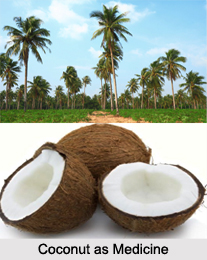 Cocus Nucifera, commonly known as Coconut, is one of the wonder foods on earth that amply provides for all human needs and has multiple health benefits. The numerous economical uses of this valuable tree are fully detailed in standard works.
Cocus Nucifera, commonly known as Coconut, is one of the wonder foods on earth that amply provides for all human needs and has multiple health benefits. The numerous economical uses of this valuable tree are fully detailed in standard works.
Health Benefits of Coconut
The water of the unripe fruit is described as a fine-flavoured, cooling, refrigerant drink useful in thirst, fever and urinary disorders. The tender pulp of the fruit is said to be nourishing, cooling and diuretic. The pulp of the ripe fruit is hard and indigestible but is used medicinally. The terminal bud of the tree is esteemed as a nourishing, strengthening and agreeable vegetable. The root of the cocoa-nut is used as a diuretic as also in uterine diseases. Coconut oil is said to promote the growth of hair. It is much used as a hair-oil by the lower classes of native women. The ashes of the leaves are used in medicine. They contain a great deal of potash. The fresh juice of the tree is considered refrigerant and diuretic. The fermented juice constitutes one of the spirituous liquors described by the ancient writers. The cleared shell of the nut or portions of it are burnt in a fire and while red hot, covered by a stone cup. The fluid deposited in the interior of the cup is rubefacient and is an effectual domestic remedy for ringworm.
Dose of Coconut in Medicine
Narikelakhanda: Take the pounded pulp of coconut, half a seer, fry it in 8 tolas of clarified butter, and afterwards boil in 4 seers of coconut water till reduced to a syrupy consistence. Now add coriander, long pepper, bamboo manna, cumin seeds, nigella seeds, cardamoms, cinnamon, tejapatra, the tubers of Cyperus rotundus (mustaka), and the flowers of Mesua ferrea (nagakesara) one tola each in fine powder and prepare a confection. Dose should be 2 to 4 tolas, in dyspepsia and consumption.
This article is a stub. You can enrich by adding more information to it. Send your Write Up to content@indianetzone.com
Related Articles
Ayurveda
Sushruta Samhita
Classification of Medicine
Properties of Material Objects and its Effect on Human Body
Indian Herbs
Traditional Indian Medicines




















